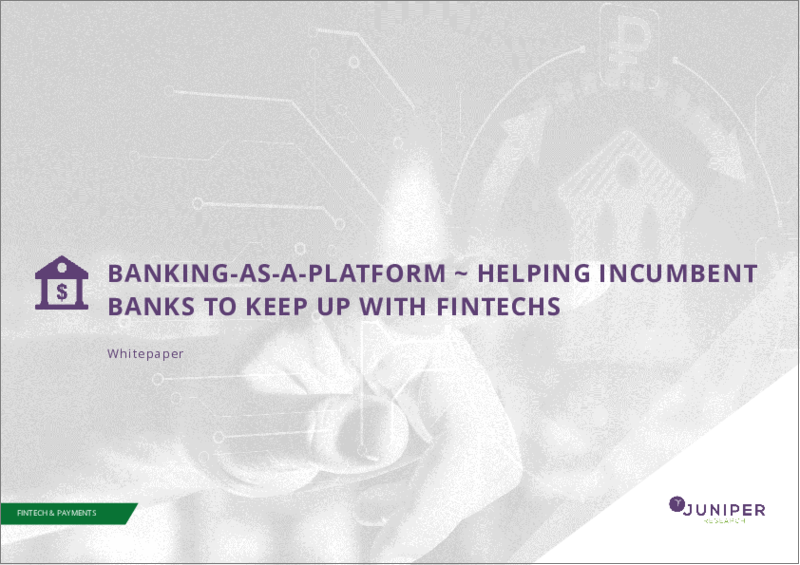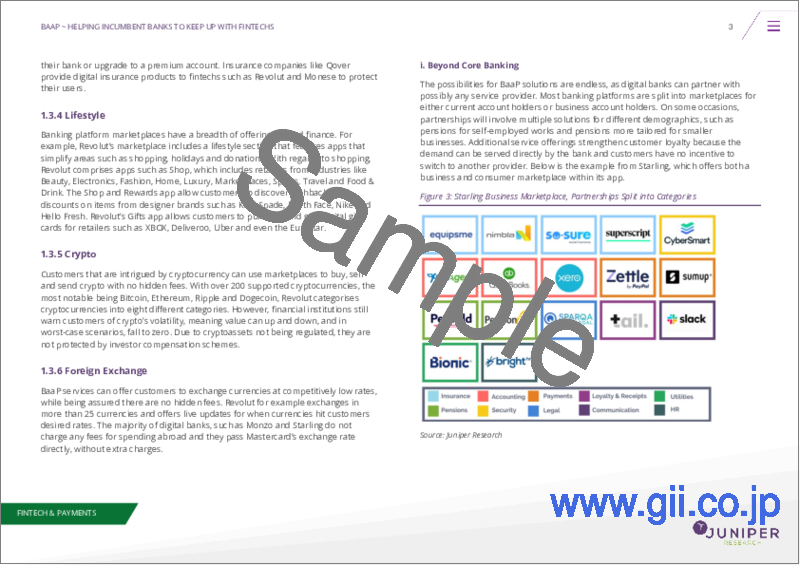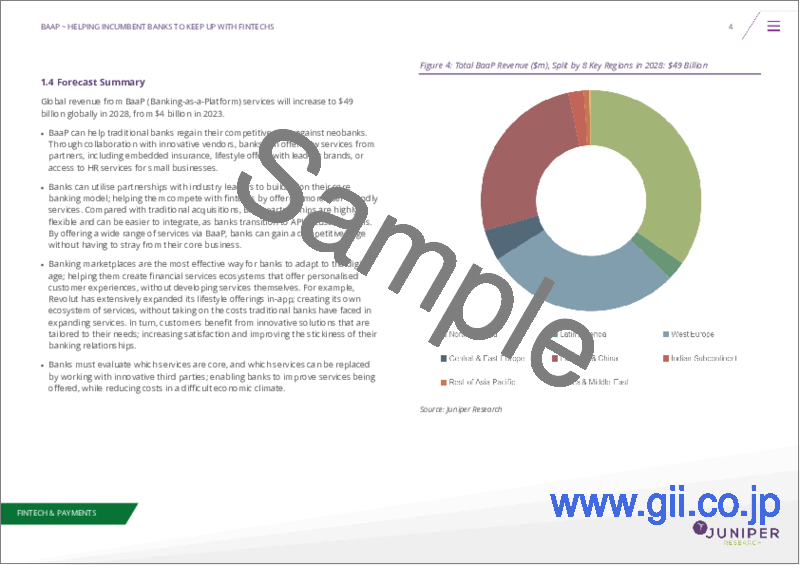|
|
市場調査レポート
商品コード
1324413
BaaP (Banking-as-a-Platform):市場予測・動向・戦略 (2023年~2028年)Banking-as-a-Platform: Market Forecasts, Trends & Strategies 2023-2028 |
||||||
|
|||||||
| BaaP (Banking-as-a-Platform):市場予測・動向・戦略 (2023年~2028年) |
|
出版日: 2023年08月07日
発行: Juniper Research Ltd
ページ情報: 英文
納期: 即日から翌営業日
|
- 全表示
- 概要
- 目次
分析概要
Juniper Research初のBaaP (Banking-as-a-Platform) を対象としたレポートでは、金融機関がサードパーティプロバイダとともにBaaPエコシステムを構築することで、どのように事業運営モデルを再構築しているかについて詳細な分析と評価を提供しています。当レポートでは、既存銀行、デジタルバンク、APIディストリビューターなど、BaaPにおけるさまざまなステークホルダーの視点と今後の展望を反映した3つの詳細なケーススタディを実施することで、BaaPが予測期間中にどのように成長するかに関する重要な洞察を提供しています。当レポートでは、主要60カ国におけるBaaPの発展を評価しています。また、中小企業、大企業、従来型銀行、ネット銀行、消費者など、BaaP市場内のさまざまな業種の現状と影響力を明らかにするセグメント分析も含まれています。
当レポートは以下の内容で構成されています:
- 市場動向、予測、戦略 (PDF・Excel)
- オンラインデータプラットフォームへのアクセス (12ヶ月間)
主な特徴
- ベンチマーク業界予測: 地域別 (全8地域)、国別 (全60ヶ国)
- 北米
- カナダ、米国
- ラテンアメリカ
- アルゼンチン、ブラジル、チリ、コロンビア、エクアドル、メキシコ、ペルー、ウルグアイ
- 西欧
- オーストリア、ベルギー、デンマーク、フィンランド、フランス、ドイツ、ギリシャ、アイルランド、イタリア、オランダ、ノルウェー、ポルトガル、スペイン、スウェーデン、スイス、英国
- 中東欧
- クロアチア、チェコ、ハンガリー、ポーランド、ルーマニア、ロシア、トルコ、ウクライナ
- 極東・中国
- 中国、香港、日本、韓国
- インド亜大陸
- バングラデシュ、インド、ネパール、パキスタン
- 他のアジア太平洋諸国
- オーストラリア、インドネシア、マレーシア、ニュージーランド、フィリピン、シンガポール、タイ、ベトナム
- アフリカ・中東
- アルジェリア、エジプト、イスラエル、ケニア、クウェート、ナイジェリア、カタール、サウジアラビア、南アフリカ、アラブ首長国連邦
- 北米
主な質問
- 1. 2028年までの世界のBaaP売上は?
- 2. BaaP (Banking-as-a-Platform) とは何か?
- 3. BaaPとPaaSの違いは?
- 4. BaaPのメリットは何か?
- 5. バンキング・マーケットプレースとは何か?
分析対象企業
- ケーススタディの対象企業: Apiture、Starling、Wells Fargo
- 言及された企業: Anorak、Bionic、BrightHR、CreditLadder、CyberSmart、Deliveroo、Envestnet Yodlee、Equipsme、Eurostar、Fidor、FreeAgent、Google、Habito、Hello Fresh、ILGA-Europe、Kate Spade、Live Oak Bank、Macmillan Cancer Support、Monese、Monzo、N26、Nike、Nimbla、North Face、Octopus Energy、OVO Energy、Penfold、PensionBee、Qover、QuickBooks、Revolut、Save the Children、Slack、Sparqa Legal、SumUp、Tail、Tandem、Uber、Wealthify、XBOX、Xero、Zettle.
予測概要
世界のBaaPサービスの世界の収益は、2023年の40億米ドルから2028年には490億米ドルに増加します。
- BaaPは、伝統的な銀行がネット銀行に対する競争力を取り戻すのに役立ちます。革新的なベンダーとの協業を通じて、銀行はパートナーから新しいサービスを提供することができます。例えば、組込型保険、一流ブランドとのライフスタイル・オファー、中小企業向けの人事サービスへのアクセスなどがあります。
- 銀行は、業界リーダーとのパートナーシップを活用して、中核銀行業務モデルを構築し、よりユーザーフレンドリーなサービスを提供することで、フィンテックに対抗することができます。従来の買収に比べ、BaaPパートナーシップは柔軟性が高く、銀行がAPI重視のモデルに移行する中で、統合が容易になる可能性があります。BaaPを通じて幅広いサービスを提供することで、銀行は本業から外れることなく競争力を得ることができます。
- バンキング・マーケットプレースは、銀行がデジタル時代に適応するための最も効果的な方法であり、銀行自身がサービスを開発することなく、パーソナライズされた顧客体験を提供する金融サービスのエコシステムを構築するのに役立ちます。例えば、Revolutはアプリ内で提供するライフスタイルを大幅に拡大し、従来型銀行がサービス拡大に直面していたコストを負担することなく、独自のサービスエコシステムを構築しています。その結果、顧客はニーズに合わせた革新的なソリューションから恩恵を受け、満足度が向上し、銀行取引関係の定着度が高まっています。
- 銀行は、どのサービスが中核で、どのサービスが革新的なサードパーティと協働することで代替可能かを評価しなければなりません。
目次
第1章 BaaP (Banking-as-a-Platform):分析概要と戦略提言
第2章 BaaP:市場情勢
- イントロダクション
- 定義と範囲
- BaaPの機能
- API (アプリケーションプログラミングインターフェイス)
- OpenAPI仕様
- 現在の市場情勢
- BaaPとBaaS
- オープンバンキングへの移行
- オープンバンキング規制
- .欧州連合と英国
- 米国
- 中国
- アフリカと中東
- 東南アジアおよびインド亜大陸
- BaaPの成功要因
- パートナーシップ
- 業績
- 透明性
- 長寿
- BaaPのサードパーティ製品
- 決済
- 資産管理・取引
- 組込型保険
- ライフスタイル
- 暗号
- 外国為替
- 中核銀行業務以外
- BaaPの課題
- サードパーティのリスク
- 規制コンプライアンス
- 中核システムと補助システムの統合
- APIの経験不足
- 現在の動向
- 今後の展望
- オープンバンキングの採用
- オープンバンキングの規制枠組みの進化
- 中小企業への注力とBaaPエコシステムの構築
- パートナーシップと収益化の幅広い機会
第3章 BaaP:セグメント分析
- セグメント分析
- サードパーティー
- 中小企業
- 大企業
- 銀行
- 従来型銀行
- ネット銀行
- 消費者
- サードパーティー
第4章 BaaP:ケーススタディ
- Starlingの個人金融マーケットプレース
- Starlingのビジネスマーケットプレース
第5章 BaaP:市場予測
- イントロダクション
- 調査手法と前提
- BaaPの予測
- BaaPビジネスアカウントの総取引量
- BaaPビジネスアカウントの総収益
- BaaP当座預金の総収益
REPORT OVERVIEW
Juniper Research's first “Banking-as-a-Platform (BaaP)” report provides in-depth analysis and evaluation of how financial institutions are reimagining their business operating model by creating a BaaP ecosystem alongside third-party providers. The research delivers critical insights on how BaaP will grow over the forecast period, by conducting three in-depth case studies that reflect the perspective of different stakeholders in BaaP such as incumbent banks, digital banks and API distributors alongside their future prospects. It provides an evaluation of the development of BaaP across 60 different key countries of interest. The study also contains a segment analysis which identifies the current status and influence of various verticals within the BaaP market, such as SMEs, large enterprises, traditional banks, neobanks and consumers.
This research delivers incisive analysis of the BaaP market landscape; looking at evolving Open Banking regulations for 5 Key regions; key challenges faced by the current market status alongside strategic recommendations highlighted by Juniper Research. This is followed by an in-depth analysis of what makes BaaP such a high performing and successful model and how it can increase transparency and longevity for incumbent banks. Furthermore, the research includes an assessment on the breadth of offerings from various segments which have demonstrated to be successful. This includes payments, wealth management and trading, embedded insurance, lifestyle, cryptocurrency, foreign exchange and more. Finally, this research also features a comprehensive forecast suite; encompassing the growth of BaaP services and the projected revenue for each segment. We have split BaaP revenue streams by business account and current account offerings; looking at interlinked areas such as:
- Accounting services
- HR & Legal services
- Insurance
- Loyalty schemes
- Mortgage services
- Payments services
- Pension services
- Wealth Management & Savings
The research suite comprises:
- Market Trends, Forecasts & Strategies (PDF & Excel)
- 12 Months' Access to harvest Online Data Platform
KEY FEATURES
- Market Dynamics: Insights into key trends and market expansion challenges within the development of the Banking-as-a-Platform model; how third-party partnerships that offer services such as payments and embedded insurance are being offered to BaaP solutions that help banks provide a personalised financial services tailored to each customer. Insights on the different offerings provided by banking platforms and how these are deployed.
- Key Takeaways & Strategic Recommendations: Key opportunities for those found in digital banking market landscape; making for an important read for key stakeholders.
- Segment Analysis: The study also contains a segment analysis which identifies the current status and influence of various verticals within the BaaP market, such as SMEs, large enterprises, traditional banks, neobanks and consumers.
- Benchmark Industry Forecasts: 5-year forecasts for the total revenue of BaaP, revenue for current account services and business account services. These are segmented across 10 different segments such as payments, embedded insurance, loyalty schemes, accounting services, pensions and more. The data is also split by our 8 key forecast regions and 60 countries:
- North America:
- Canada, US
- Latin America:
- Argentina, Brazil, Chile, Colombia, Ecuador, Mexico, Peru, Uruguay
- West Europe:
- Austria, Belgium, Denmark, Finland, France, Germany, Greece, Ireland, Italy, Netherlands, Norway, Portugal, Spain, Sweden, Switzerland, UK
- Central & East Europe:
- Croatia, Czech Republic, Hungary, Poland, Romania, Russia, Turkey, Ukraine
- Far East & China:
- China, Hong Kong, Japan, South Korea
- Indian Subcontinent:
- Bangladesh, India, Nepal, Pakistan
- Rest of Asia Pacific:
- Australia, Indonesia, Malaysia, New Zealand, Philippines, Singapore, Thailand, Vietnam
- Africa & Middle East:
- Algeria, Egypt, Israel, Kenya, Kuwait, Nigeria, Qatar, Saudi Arabia, South Africa, United Arab Emirates
KEY QUESTIONS ANSWERED
- 1. What will the Global BaaP Revenue be by 2028?
- 2. What is banking-as-a-platform?
- 3. What is the difference between banking-as-a-service and platform-as-a-service?
- 4. What are the benefits of banking-as-a-platform?
- 5. What is a banking marketplace and what do they offer?
COMPANIES REFERENCED
- Case Studied: Apiture, Starling, Wells Fargo
- Mentioned: Anorak, Bionic, BrightHR, CreditLadder, CyberSmart, Deliveroo, Envestnet Yodlee, Equipsme, Eurostar, Fidor, FreeAgent, Google, Habito, Hello Fresh, ILGA-Europe, Kate Spade, Live Oak Bank, Macmillan Cancer Support, Monese, Monzo, N26, Nike, Nimbla, North Face, Octopus Energy, OVO Energy, Penfold, PensionBee, Qover, QuickBooks, Revolut, Save the Children, Slack, Sparqa Legal, SumUp, Tail, Tandem, Uber, Wealthify, XBOX, Xero, Zettle.
DATA & INTERACTIVE FORECAST
Juniper Research's forecast suite provides industry benchmark forecasts for the “BaaP” market includes:
- Forecasts split by consumer vs business services, as well as transactions volume for payments and third party offerings from financial services including:
- Accounting services
- HR & Legal services
- Insurance
- Loyalty schemes
- Mortgage services
- Payments services
- Pension services
- Wealth Management & Savings
- Interactive scenario tool allowing users to manipulate Juniper Research's data for 5 different metrics.
- Access to the full set of forecast data of 113 tables and more than 46,890 datapoints.
Geographical splits: 60 countries
harvest: Our online data platform, harvest, contains the very latest market data and is updated throughout the year. This is a fully featured platform enabling clients to better understand key data trends and manipulate charts and tables; overlaying different forecasts within the one chart - using the comparison tool. Empower your business with our market intelligence centre, and receive alerts whenever your data is updated.
Interactive Excels (IFxl): Our IFxl tool enables clients to manipulate both forecast data and charts, within an Excel environment, to test their own assumptions using the interactive scenario tool and compare selected markets side by side in customised charts and tables. IFxls greatly increase a client's ability to both understand a particular market and to integrate their own views into the model.
FORECAST SUMMARY
Global revenue from BaaP (Banking-as-a-Platform) services will increase to $49 billion globally in 2028, from $4 billion in 2023.
- BaaP can help traditional banks regain their competitive edge against neobanks. Through collaboration with innovative vendors, banks can offer new services from partners, including embedded insurance, lifestyle offers with leading brands, or access to HR services for small businesses.
- Banks can utilise partnerships with industry leaders to build upon their core banking model; helping them compete with fintechs by offering more user-friendly services. Compared with traditional acquisitions, BaaP partnerships are highly flexible and can be easier to integrate, as banks transition to API-focused models. By offering a wide range of services via BaaP, banks can gain a competitive edge without having to stray from their core business.
- Banking marketplaces are the most effective way for banks to adapt to the digital age; helping them create financial services ecosystems that offer personalised customer experiences, without developing services themselves. For example, Revolut has extensively expanded its lifestyle offerings in-app; creating its own ecosystem of services, without taking on the costs traditional banks have faced in expanding services. In turn, customers benefit from innovative solutions that are tailored to their needs; increasing satisfaction and improving the stickiness of their banking relationships.
- Banks must evaluate which services are core, and which services can be replaced by working with innovative third parties; enabling banks to improve services being offered, while reducing costs in a difficult economic climate.
Table of Contents
1. Banking-as-a-Platform - Key Takeaways & Strategic Recommendations
- 1.1. Key Takeaways
- 1.2. Strategic Recommendations
2. Banking-as-a-Platform - Market Landscape
- 2.1. Introduction
- 2.1.1. Definitions & Scope
- 2.1.2. Functionalities of BaaP
- Figure 2.1: How BaaP Works
- 2.2. APIs (Application Programming Interfaces)
- Figure 2.2: How APIs Work
- i. OpenAPI Specification
- 2.3. Current Market Landscape
- 2.3.1. BaaP Versus BaaS
- Figure 2.3: BaaP vs BaaS
- 2.3.2. The Shift to Open Banking
- 2.3.3. Open Banking Regulations
- i. The European Union & UK
- ii. US
- iii. China
- iv. Africa & the Middle East
- v. South East Asia and Indian Subcontinent
- 2.3.4. What Makes BaaP Successful
- i. Partnerships
- ii. Performance
- iii. Transparency
- iv. Longevity
- 2.3.5. BaaP Third-party Offerings
- Figure 2.4: Banking-as-a-Platform Key Third-party Offerings
- i. Payments
- ii. Wealth Management & Trading
- iii. Embedded Insurance
- iv. Lifestyle
- v. Crypto
- vi. Foreign Exchange
- vii. Beyond Core Banking
- 2.3.6. BaaP Challenges
- i. Third-party Risk
- ii. Regulatory Compliance
- iii. Core and Ancillary System Integration
- iv. Lack of API Experience
- 2.3.1. BaaP Versus BaaS
- 2.4. Current Trends
- 2.5. Future Outlook
- 2.5.1. Embracing Open Banking
- 2.5.2. The Evolving Open Banking Regulatory Framework
- 2.5.3. Focus on Smaller Businesses and Creating a BaaP Ecosystem
- 2.5.4. Expansive Opportunities for Partnerships and Monetisation
3. Banking-as-a-Platform - Segment Analysis
- 3.1. Segment Analysis
- 3.1.1. Third Parties
- i. SMEs
- ii. Large Enterprises
- 3.1.2. Banks
- i. Traditional Banks
- ii. Neobanks
- 3.1.3. Consumers
- 3.1.1. Third Parties
4. Banking-as-a-Platform - Case Studies
- 4.1.1. Starling's Personal Finance Marketplace
- Figure 4.1: Starling Personal Finance Marketplace, Partnerships Split into Sector Categories
- 4.1.2. Starling's Business Marketplace
- Figure 4.2: Starling Business Marketplace, Partnerships Split into Sector Categories
5. Banking-as-a-Platform - Market Forecasts
- 5.1. Introduction
- 5.2. Methodology & Assumptions
- Figure 5.1: BaaP Forecast Methodology, Current Accounts - Savings & Wealth Management
- Figure 5.2: BaaP Forecast Methodology, Current Accounts - Insurance Services
- Figure 5.3: BaaP Forecast Methodology: Current Accounts - Pension Services
- Figure 5.4: BaaP Forecast Methodology: Current Accounts - Mortgage Services
- Figure 5.5: BaaP Forecast Methodology: Current Accounts - Loyalty & Reward Schemes
- Figure 5.6: BaaP Forecast Methodology: Business Accounts - Payments
- Figure 5.7: BaaP Forecast Methodology: Business Accounts - Pension Services
- Figure 5.8: BaaP Forecast Methodology: Business Accounts - Insurance Services
- Figure 5.9: BaaP Forecast Methodology: Business Accounts - Accounting Services
- Figure 5.10: BaaP Forecast Methodology: Business Accounts - HR & Legal Services
- 5.3. BaaP Forecasts
- 5.3.1. Total BaaP Business Account Transaction Volume
- Figure & Table 5.11: Total Value of Business Account BaaP Transactions (m), Split by 8 Key Regions, 2023-2028
- 5.3.2. Total BaaP Business Account Revenue
- Figure & Table 5.12: Total BaaP Business Account Revenue ($m), Split by 8 Key Regions, 2023-2028
- Table 5.13: Total BaaP Business Account Revenue ($m), Split by Service, 2023-2028
- 5.3.3. Total BaaP Current Account Revenue
- Figure & Table 5.13: Total BaaP Current Account Revenue ($m), Split by 8 Key Regions, 2023-2028
- Table 5.14: Total BaaP Current Account Revenue ($m), Split by Service, 2023-2028
- 5.3.1. Total BaaP Business Account Transaction Volume






